| 1 | Red-naped snake (Aus) |
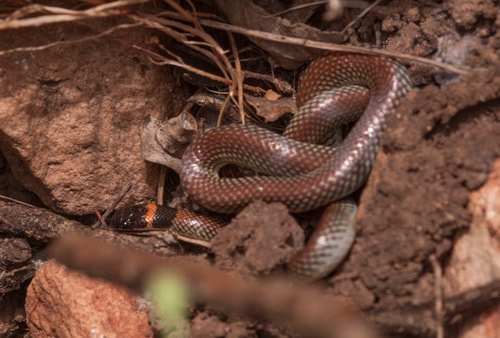
A common species in eastern Australia, not least because of their natural instincts for shelter. A thick leaf bed is one of their favourite places to bury themselves in. Red-naped snakes (Furina diadema) measure just 45cm, and their venom is no threat to humans. They’re timid and will only bite if provoked again and again. Red-naped snakes dwell in woodlands, grasslands, parks and dry forests alike. They’re mainly guided by moisture, avoiding bone dry outback, but also rainforests.
Compared to a red-bellied black snake, there’s no comparison. The former charges around thuggishly, biting whatever it feels like, while the red-naped snake dislikes being overexposed. They would rather stick to a cosy, leafy forest glade, where they can wait patiently for skink lizards (their main prey) to walk past.
In human encounters, they try to hide, sinking lower into leaves, or make a bluff strike with their mouth closed. You might meet this snake if you have a picnic in the woods, or drop a coin and start rummaging through a leaf bed frantically. Red-naped snakes range from south to north: from populous Victoria to the dry heat of Queensland.
| 2 | Copperhead |
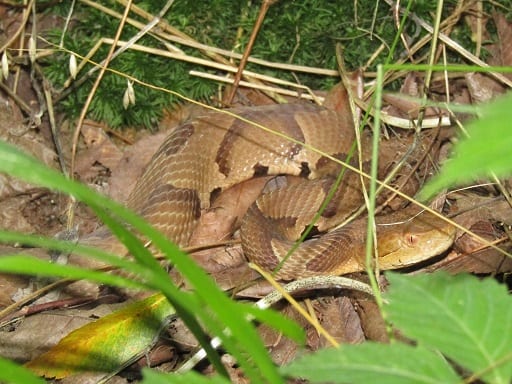
The copperhead spends its days on leafy woodland floors, and has one of the best disguises for doing so on the planet. Copperheads have a haemorrhagic venom and inhabit most of the eastern US, from Ohio to Texas. They’re a bulky 70-90cm and rely on ambush tactics. When completely still, which they commonly are, they can be impossible to spot. Many “spot the snake” photographs have been published featuring virtually invisible copperheads.
This species likes moderately sparse woodlands rather than dense forests, and particularly those with a thick coating of leaves. Copperheads sometimes bury themselves in leaf piles, but mimic leaves so accurately with their colours that they barely need to. It’s this disguise and their immobile ways which make them such a threat to humans. A golden eye gleaming at you may be the only chance you have. Luckily, their venom isn’t the worst in the world, and is usually survivable.
The cottonmouth and copperhead are cousins (Agkistrodon family), yet have spiralled in different directions. Cottonmouths live in swamps and are now a murky-dark brown. Copperheads live in leafy woodlands, and have gained beige and light brown scales with vaguely triangular bands. If a cottonmouth entered these drier, autumnal worlds, it would die, and vice versa.
| 3 | Red-tailed pipe snake |
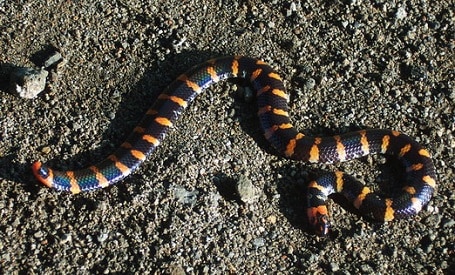
This southeast Asian species sticks to marshy forests, sometimes invading agricultural areas. You can recognise them by an iridescent sheen, and a thin white band on their neck.
Red-tailed pipe snakes have a specially modified snout, which they often use to dig into leafy mulch, accumulated over many months, and completely disappear. In those leafy tunnels, they can become completely invisible, particularly to aggressive yet clumsy predators such as the king cobra, which gets most of its calories from other snakes.
Some snakes rely on corrosive venom to frighten their enemies, but this snake is humbler and would rather disappear below. Red-tailed pipe snakes reach 100cm and are near black, overlaid with white or orange stripes. They’re no threat to humans, and normally waggle a reddish tail tip when threatened. They’re also a strong swimmer, and most of their prey consists of other snakes. In their leafy forested realms, they have plenty to choose from. The red-tailed pipe snake vanishes into a thick bed of leaves, and isn’t seen again until it decides it wants to be.
| 4 | Mexican jumping pitviper |
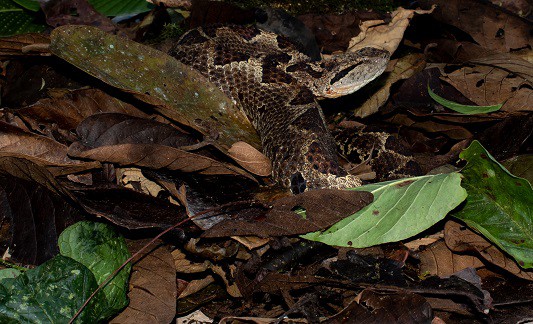
The Mexican jumping viper has one of the weakest skillsets of the viper family. They almost never climb trees, they lack the stomach for a fight. Even their “jumping” name is a complete misconception, and they have an unexceptional strike distance.
Instead, Metlapilcoatlus nummifer compensates by being a master of disguise, and leaf piles are one of their favourite places to lurk. This snake lives in southern Mexico, and rarely appears in open grasslands, as there’s no accumulated leaves to lurk in. Instead, they like rainforests and cloud forests, the mulchier the better.
Mexican jumping vipers have a triangular head, and various shades of brown overlapping in triangular patterns. Even when moving, Metlapilcoatlus nummifer is difficult to distinguish against a thick bed of leaves. When stationary, there’s no chance. This is a slow snake which relies completely on ambush. Even their tongue is primed for camouflage, with a brown base that gets blacker towards the tip. Mexican jumping vipers average at 50cm, and bites are very rare in human beings. Poking them isn’t advised though.
| 5 | Smooth scaled death adder |
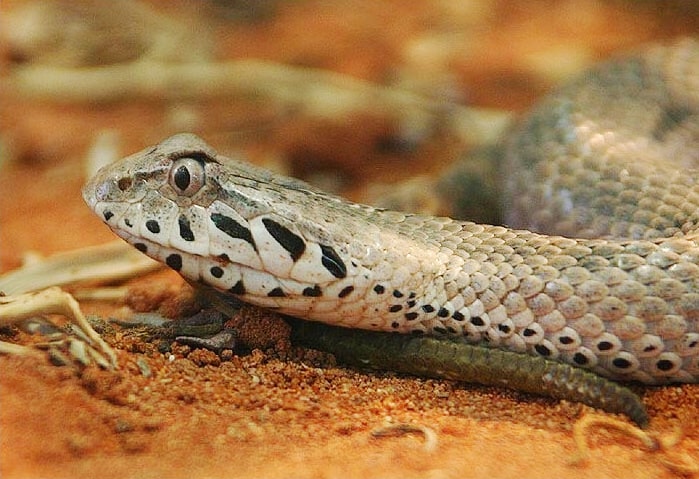
One of New Guinea’s most feared snakes. This dangerously venomous brute inhabits the Indonesia (west) half of the island, and Papua New Guinea to the east. If you could see the smooth-scaled death adder charging at you down a hill, then you’d at least know what you were dealing with, facing your worst nightmare head on. But instead, they love to bury themselves in piles of leaves.
This is mainly an ambush strategy, as all death adder species like to spring out at unsuspecting rodents walking past. With beige-brown scales, they blend in perfectly, except for their large size. Smooth-scaled death adders (Acanthophis laevis) reach 40-60cm, but are thick and could probably knock a human over as they burst from their leafy piles.
Alongside Papuan black snakes, this is the island’s number 1 snake villain, as their leafy disguises make them so hard to notice. Death adders also hide in bushes, but rock piles are too stiff, while fallen branches don’t cover enough area. Leaves are the ultimate invisibility cloak both for disguise and effortlessly bursting out of.
| 6 | Red bamboo snake |
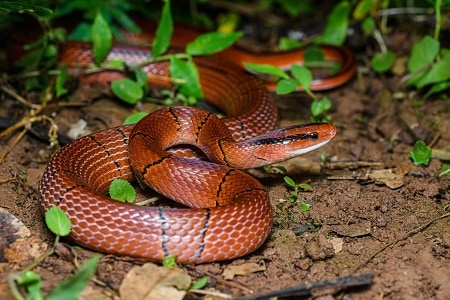
A highly sought after snake by reptile keepers. The red bamboo snake once belonged to the large Elaphe ratsnake family, but is now the sole member of the Oreocryptophis family, due to genetic differences. Collectors cannot resist its elegant red body overlaid with black stripes, although not many are available in the international trade.
This snake ranges from India to Thailand and Sumatra. Just as a cow’s favourite place is a grassy field, the red bamboo snake loves nothing more than a leafy forest floor. By pointing their thin head downwards and digging, they can bury themselves in these leaves and become invisible to passers-by. Red bamboo snakes are usually found under cover of some kind, often logs and rocks, but usually leaves. Forests are their home, and they prefer cooler conditions, at altitudes of 800 metres or more. Damp mountain forests are their main base.
With striking red colours, you’d think that red bamboo snakes would stick out, but they disappear effortlessly in leaves. They’re less hyper than many ratsnakes and wait calmly in their leafy disguises, hoping for rodents to walk past. Mammals are their main prey, and they happily swallow rats in captivity.
| 7 | Dwarf reed snake |
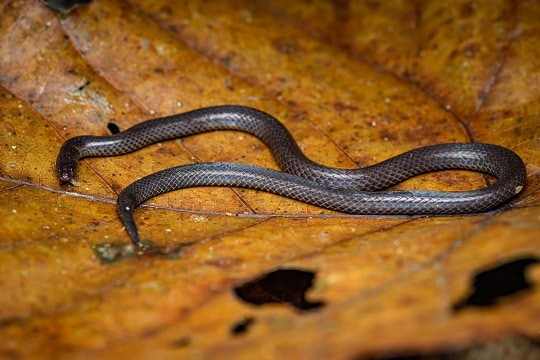
This species is semi-fossorial, spending much of its time underground. When they do surface, they usually stay in a comforting bed of leaves. Dwarf reed snakes live in southeast Asia (Thailand, Singapore) and are extremely docile. If you poked your arm into leaves and accidentally touched one, it almost certainly wouldn’t bite (though you might have a heart attack).
Dwarf reed snakes have very small mouths, which could probably only pierce a human finger. Living in humid forests, and hiding under thick leaf beds, this species is seen by humans only rarely. Life is comfortable in their leafy worlds, as plenty of earthworms (their main prey) are found just below. If tired, they can switch off and go to sleep instantly, knowing that birds above can’t see them.
Ground animals are another story; a king cobra rummaging through a leaf bed could easily unearth the dwarf reed snake and gobble them up. Nevertheless, it’s better to be harmless and hidden than harmless and completely exposed, and that’s the choice the dwarf reed snake has made. They also have an unusual escape method: cartwheeling.
| 8 | Dumeril’s kukri snake |
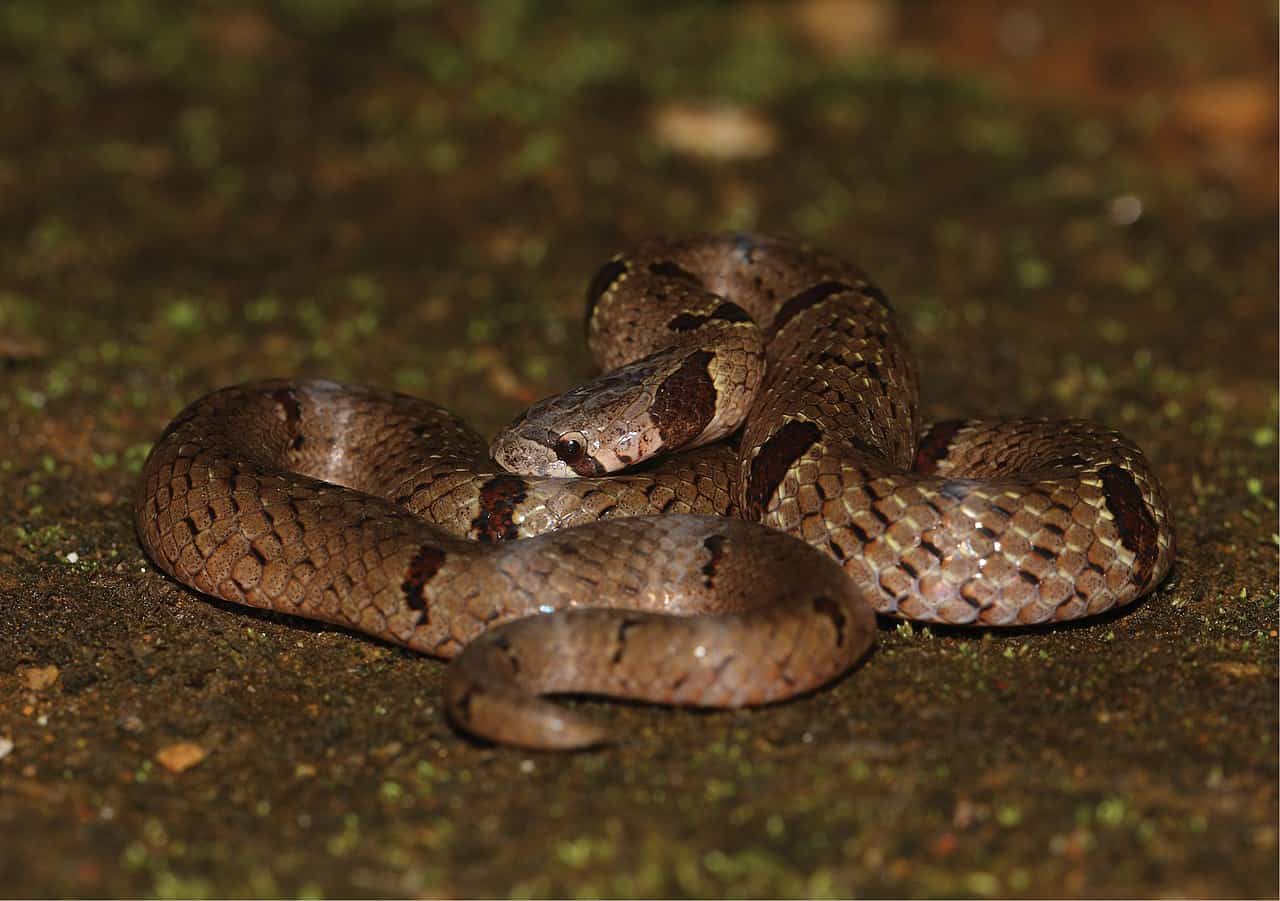
Some snakes are thin and ultra green, to mimic a swinging vine. Some are so venomous that birds won’t go anywhere near them. Burying yourself in leaves is a humbler yet equally effective survival strategy, one used by Dumeril’s kukri snake, a 40cm species which is abundant in Sri Lanka.
This species lives in sparser, thinner forests, with decent visibility, yet a large sea of leaves which it can easily dive into. Dumeril’s kukri snake is mildly venomous, yet completely non-aggressive. When confronted, they flatten their body in an attempt to appear larger. Disguise is key to survival, and as long as leaf litter is nearby, Dumeril’s kukri snake will always have a get out of jail free card. This species is particularly common in the central Sri Lanka hills and the drier north. They have extremely sharp teeth, perfect for slashing through reptile eggs.
Its disguise is excellent, with a reddish-brown base are overlaid with darker brown stripes. One of these stripes passes directly through its eye, masking the pupils peering out at predators. Dumeril’s kukri snakes have a thin, net-like pattern, which switches between black and white.
| 9 | Fer-de-lance |
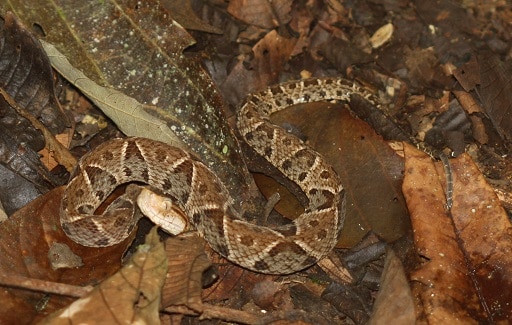
The fer-de-lance lives in Central America and reaches 2.5 metres. Per total fear quotient generated, it’s one of the worst snakes to crawl Planet Earth. Its venom kills with ease and they have a giant venom yield of 456mg. However, they don’t seem to realise how feared they are, and regularly take shelter under leaf piles.
With brown-beige colours and sweeping zigzags similar to a cottonmouth, they blend in with ease. Their appearance is perfectly optimised, as if they were green, they’d stick out like a sore thumb. The fer-de-lance is notorious because they not only lurk in leaf piles, but move explosively fast when they do activate. In some states of Colombia, fer-de-lances cause 50% of snakebites. The Latin name is Bothrops asper, with asper translating to “rough” or “harsh”. Whether this references their scales or personality is unknown.
The fer-de-lance doesn’t always hiss from its cosy leaf pile either. They can burst out without warning. Alternatively, they can let you walk past unscathed, keeping a close eye on you. The fer-de-lance is notoriously unpredictable, whether hiding in leaves or patrolling the forest.
| 10 | Aesculapian false coral snake |
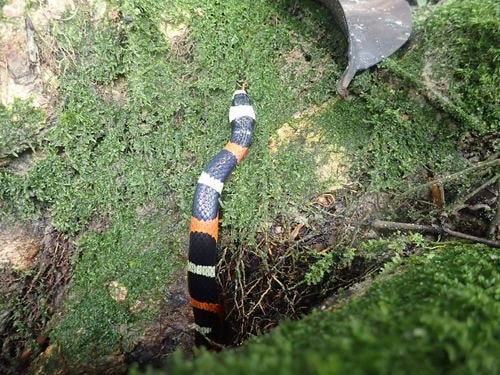
A rainforest has endless miniature niches that snakes can claim, resulting in countless non-competing snakes coexisting. There’s burrows, open ground, high branches, low branches, bushes. Leaf litter is another, and the Aesculapian false coral snake has taken this slot in Brazil. This is a mildly venomous species measuring 70cm, which mainly feeds on fellow snakes.
Hiding in leaf beds is one way to stay alive, in the brutal Amazon rainforest where just one false move could mean death. Another is mimicry, as this species is clearly mimicking venomous coral snakes. They have red, white and black bands, and even their leaf-loving ways are similar. Both species stick to the forest floor, rarely climbing trees.
The Latin name of this snake is Erythrolampus aesculapii, which is derived from Asclepios, the Greek god of healing. This species also has decent burrowing skills, used in soft rainforest soil. Their venom is not strong enough to compete in a pitched battle, and they’re not bulky, so hiding in leaves is their smartest choice.
